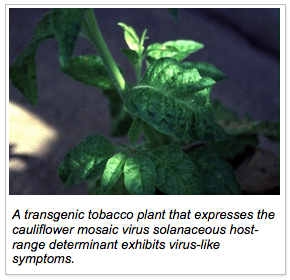James E. Schoelz

Professor
Division of Plant Science and Technology
E-mail: Schoelzj at missouri dot edu
Office address: 106 Waters Hall
Office phone: 573-882-1185
Lab address: 108 Waters Hall
Lab phone: 573-882-3068
The goal of my program is to understand the environmental and genetic factors that influence the pathogenicity and host range of plant viruses. We have identified a gene in cauliflower mosaic virus (CaMV) that triggers a hypersensitive defence response in solanaceous species. The hypersensitive response (HR) to plant pathogens, including plant viruses, is defined as a resistance response in which the plant pathogen remains localized in necrotic lesions on the inoculated leaf. In general, necrosis and resistance are closely associated, and considered physiologically and genetically linked phenomena.
 We have found that the HR of Nicotiana edwardsonii to CaMV can be genetically separated into resistance and necrosis traits that are derived from two different plant species. N. edwardsonii is a solanaceous plant that originated from a cross between N. glutinosa and N. clevelandii. We have recently shown that a single gene derived from N. glutinosa conditions resistance to CaMV, but plants react with localized chlorotic lesions rather than necrotic lesions. In contrast, N. clevelandii is susceptible to CaMV. A single gene derived from N. clevelandiitriggers the development of necrosis, both local and systemic, in response to CaMV infection. When present together in N. edwardsonii, these two plant genes condition a resistance response in which the plant responds with necrotic lesions. In the future we plan to identify and clone these plant genes, as they could provide new insights into how viruses cause symptoms in plants and how plants resist viral infections.
We have found that the HR of Nicotiana edwardsonii to CaMV can be genetically separated into resistance and necrosis traits that are derived from two different plant species. N. edwardsonii is a solanaceous plant that originated from a cross between N. glutinosa and N. clevelandii. We have recently shown that a single gene derived from N. glutinosa conditions resistance to CaMV, but plants react with localized chlorotic lesions rather than necrotic lesions. In contrast, N. clevelandii is susceptible to CaMV. A single gene derived from N. clevelandiitriggers the development of necrosis, both local and systemic, in response to CaMV infection. When present together in N. edwardsonii, these two plant genes condition a resistance response in which the plant responds with necrotic lesions. In the future we plan to identify and clone these plant genes, as they could provide new insights into how viruses cause symptoms in plants and how plants resist viral infections.
We have also shown that CaMV DNA is able to recombine with plant chromosomes and acquire sequences that can alter its host range and symptoms. This is important, because it means that plant and virus genetic material can be exchanged in nature. In order to study the mechanisms of recombination between CaMV and the plant, trangenic N. bigelovii plants were created that express a CaMV gene. When other CaMV strains were inoculated into these transgenic plants, we found that a high proportion (approximately 30%) had recombined with the transgene.
Squires J, Gillespie T, Schoelz JE, Palukaitis P. Excision and episomal replication of cauliflower mosaic virus integrated into a plant genome. Plant Physiology 2011;155(4):1908-1919.
Angel CA, Hsieh Y-C, Schoelz JE. Comparative analysis of the capacity of tombusvirus P22 and P19 proteins to function as avirulence determinants in Nicotiana species. Molecular Plant-Microbe Interactions 2011;24(1):91-99.
Harries PA, Schoelz JE and Nelson RS. Intracellular transport of viruses and their components: Utilizing the cytoskeleton and membrane highways. Molecular Plant-Microbe Interactions 2010;23(11):1381-1393.
Fang ZD, Marois JJ, Stacey G, Schoelz JE, English JT and Schmidt FJ. Combinatorial selected peptides for protection of soybean against Phakopsora pachyrhizi. Phytopathology 2010;100(10):1111-1117.
Harries PA, Schoelz JE and Nelson RS. Covering common ground f-actin-dependent transport of plant viral protein inclusions reveals a novel mechanism for movement utilized by unrelated viral proteins. Plant Signaling and Behavior 2009;4(5):454-456.
Harries PA, Palanichelvam K, Yu W, Schoelz JE and Nelson RS. The cauliflower mosaic virus protein P6 forms motile inclusions that traffic along actin microfilaments and stabilize microtubules. Plant Physiology 2009;149(2):1005-1016.
Shivaprasad PV, Rajeswaran R, Blevins T, Schoelz J, Meins Jr F, Hohn T and Pooggin MM. The CaMV transactivator/viroplasmin interferes with RDR6-dependent trans-acting and secondary siRNA pathways in Arabidopsis. Nucleic Acids Research 2008;36(18):5896-5909.
Hapiak M, Li Y, Agama K, Swade S, Okenka G, Falk J, Khandekar S, Raikhy G, Anderson A, Pollock J, Zellner W, Schoelz J and Leisner SM. Cauliflower mosaic virus gene VI product N-terminus contains regions involved in resistance-breakage, self-association and interactions with movement protein. Virus Research 2008;138(1-2):119-129.
Balaji B, Cawly J, Angel C, Zhang Z, Palanichelvam K, Cole A and Schoelz J. Silencing of the N family of resistance genes in Nicotiana edwardsonii compromises the hypersensitive response to tombusviruses. Molecular Plant-Microbe Interactions 2007;20(10):1262-1270.
Shababi M, Bourque J, Palanichelvam K, Cole A, Xu D, Wan XF and Schoelz J. The ribosomal shunt translation strategy of Cauliflower mosaic virus has evolved from ancient long terminal repeats. Journal of Virology 2006;80(8):3811-3822.
Schoelz JE, Wiggins BE, Wintermantel WM and Ross K. Introgression of a tombusvirus resistance locus from Nicotiana edwardsonii van Columbia to N. clevelandii. Phytopathology 2006;96(5):453-459.
Cawly J, Cole AB, Kiraly L, Qiu W and Schoelz JE. The plant gene CCD1 selectively blocks cell death during the hypersensitive response to cauliflower mosaic virus infection. Molecular Plant-Microbe Interactions 2005;18(3):212-219.
Cole AB, Kiraly L, Lane LC, Wiggins BE, Ross K and Schoelz JE. Temporal expression of PR-1 and enhanced mature plant resistance to virus infection is controlled by a single dominant gene in a new Nicotiana hybrid. Molecular Plant-Microbe Interactions 2004;17(9):976-985.
Yu W, Murfett J and Schoelz JE. Differential induction of symptoms in Arabidopsis by P6 of Cauliflower mosaic virus. Molecular Plant-Microbe Interactions 2003;16(1):35-42.
Palanichelvam K and Schoelz JE. A comparative analysis of the avirulence and translational transactivator functions of gene VI of Cauliflower mosaic virus. Virology 2002;293(2):225-233.
Agama K, Beach S, Schoelz J and Leisner SM. The 5' third of Cauliflower mosaic virus gene VI conditions resistance breakage in Arabidopsis ecotype Tsu-0. Phytopathology 2002;92(2):190-196.
Kloek AP, Verbsky ML, Sharma SB, Schoelz JE, Vogel J, Klessig DF and Kunkel BN. Resistance to Pseudomonas syringae conferred by an Arabidopsis thaliana coronatine-insensitive (coi1) mutation occurs through two distinct mechanisms. Plant Journal 2001;26(5):509-522.
Cole AB, Kiraly L, Ross K and Schoelz JE. Uncoupling resistance from cell death in the hypersensitive response of nicotiana species to cauliflower mosaic virus infection. Molecular Plant-Microbe Interactions 2001;14(1):31-41.
Palanichelvam K, Cole AB, Shababi M and Schoelz JE. Agroinfiltration of Cauliflower mosaic virus gene VI elicits hypersensitive response in Nicotiana species. Molecular Plant-Microbe Interactions 2000;13(11):1275-1279.